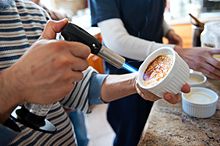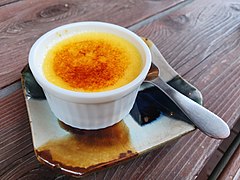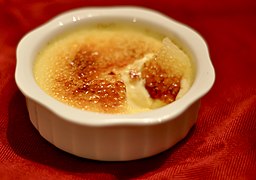Cookbook:Crème Brûlée
Cookbook | Recipes | Ingredients | Equipment | Techniques | Cookbook Disambiguation Pages

Crème brûlée, also called burnt cream or Trinity cream, is a sweet baked custard topped with a layer of hard caramelized sugar. Its exact origin is debated, but it arose in Western Europe by the 17th century. It should not be confused with crème caramel.
Characteristics
[edit | edit source]The custard base of crème brûlée is richly creamy and thick-set, typically made with a milk/cream mixture, sugar, and eggs or egg yolks. This plain base can be augmented with a range of flavorings, including chocolate, vanilla, orange, coffee, etc. The caramelized sugar layer on top is amber in color and crunchy, with a nutty caramelized flavor. The thickness of the caramelized sugar can vary—some cooks will use a light touch, leaving only a few droplets of caramelized sugar on top, while others may create a thick, glass-like layer of crunchy caramelized sugar.
Techniques
[edit | edit source]
Custard
[edit | edit source]The custard base for crème brûlée is made by heating cream and/or milk, infusing it with any desired flavors, and tempering it into sugar and eggs/yolks. Using a high proportion of cream relative to milk yields a creamier and richer final product. Using only egg yolks, as opposed to whole eggs, also makes the custard creamier due to their fat and emulsifying lecithin content. When combining all the ingredients, over-whisking should be avoided to prevent the incorporation of excess air into the mixture.
The base is then transferred to dishes or ramekins, followed by gentle cooking/baking to carefully set the base into a smooth, creamy custard. Often a bain-marie or water bath is used to provide gentle heating.
Flavoring
[edit | edit source]Crème brûlée can be infused with a variety of flavors. Typically, solid flavorants like coffee beans, vanilla beans, tea leaves, citrus peel, chocolate, and various herbs are allowed to infuse in the hot milk/cream. Liquid extracts are usually stirred into the final custard base before baking.
Caramelized sugar
[edit | edit source]For the sugar topping, intense, direct heat is required to melt and caramelize the sugar without curdling the custard base. Historically, this was achieved by holding an extremely hot metal tool called a salamander in close proximity to the sugar. In modern cooking, a blowtorch is preferred for achieving the same controlled effect. If a blowtorch is not available, the sugar may be caramelized using the broiler feature of an oven, but this method is less precise and can lead to burning of the sugar and/or curdling of the custard.
The type of sugar used may vary, but white granulated sugar is the most typical nowadays. Superfine sugar can melt and burn too quickly, and icing sugar will dissolve and not caramelize properly. Darker sugars with higher molasses content (e.g. brown sugar) can provide a richer flavor, but they can make a stickier caramel and it's harder to judge the degree of caramelization with them.
Storage
[edit | edit source]After the custard has been baked, it must be cooled. During this period, it can be stored in the fridge or frozen for up to a month. Once the sugar topping has been added and caramelized, the finished crème brûlées do not keep well, since the topping will start to soften and dissolve.
Gallery
[edit | edit source]Recipes
[edit | edit source]External links
[edit | edit source]- https://www.theguardian.com/lifeandstyle/wordofmouth/2012/sep/20/how-to-cook-perfect-creme-brulee
- https://www.kingarthurbaking.com/recipes/classic-creme-brulee-recipe
- https://www.tasteatlas.com/creme-brulee
- https://www.masterclass.com/articles/easy-vanilla-creme-brulee-recipe
- https://www.thespruceeats.com/creme-brulee-recipe-995153
- https://www.gourmandise.com/blog/alittlehistorycremebrulee
- https://foodcrumbles.com/science-of-creme-brulee/
- https://cooking.nytimes.com/recipes/9039-vanilla-creme-brulee
- https://www.simplyrecipes.com/recipes/how_to_make_creme_brulee/







